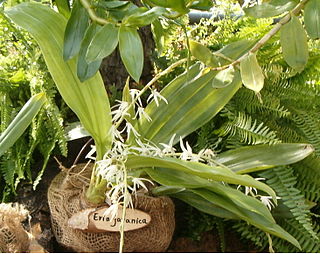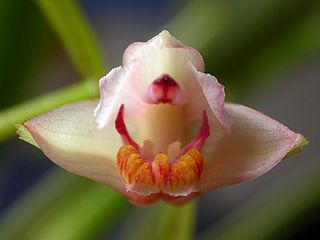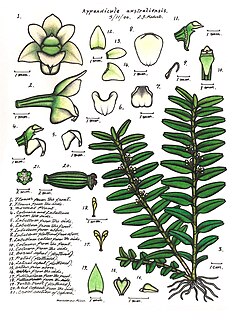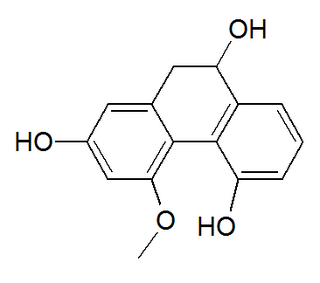
Phenanthrenoids are chemical compounds formed with a phenanthrene backbone. These compounds occur naturally in plants, although they can also be synthesized.

Eria is a genus of orchids with more than 50 species distributed in China, the Himalayas, the Indian Subcontinent, Southeast Asia, New Guinea, Polynesia, Melanesia and Micronesia.

Dendrobium nobile, commonly known as the noble dendrobium, is a member of the family Orchidaceae. It has become a popular cultivated decorative house plant, because it produces colourful blooms in winter and spring, at a time when little else is in flower. It is also one of the 50 fundamental herbs used in traditional Chinese medicine, known as shí hú or shí hú lán. Dendrobium nobile is one of the most widespread ornamental members of the orchid family. Its blooms are variegated in colour, shading from white through pink and purple, and the many different cultivated varieties produce different sized and coloured blooms.

Bulbophyllum vaginatum is a species of orchid.

Coelogyne cristata is an epiphytic orchid that comes from cool, moist areas of the eastern Himalayas and Vietnam. It blooms every spring, before the snow begins to melt. Its genus name Coelogyne originates from two Greek words, koilos (“hollow”) and gyne (“woman”), because of the orchid’s pistil. Cristata takes its species name from crista, the Latin word for “comb”, because of the look of the flower’s lip.

Cryptochilus roseus is a species of orchid. It is native to Hong Kong and Hainan in southern China.

Maxillaria densa, the crowded maxillaria, is a species of orchid ranging from Mexico south to Nicaragua.
Bulbophyllum reptans is a species of orchid in the genus Bulbophyllum.

Cryptochilus is a genus of flowering plants from the orchid family, Orchidaceae. Its species are native to China, the Himalayas, and Indochina.

The Eriinae form a subtribe of Podochileae, a tribe of the orchid family (Orchidaceae). The name is derived from the genus Eria.

Podochileae is an orchid tribe in the subfamily Epidendroideae.

Plicatol A is one of the three phenanthrenes that can be isolated from the stems of the orchid Dendrobium plicatile.

Plicatol C is one of the three phenanthrenes that can be isolated from the stems of the orchid Flickingeria fimbriata.

Nudol is a phenanthrenoid of the orchids Eulophia nuda, Eria carinata, Eria stricta and Maxillaria densa.

Coeloginanthrin is a phenanthrenoid found in the orchid Coelogyne cristata.

Confusarin is a phenanthrenoid found in the orchids Eria confusa and Bulbophyllum reptans. It can also be synthesized.

Corybas acuminatus, commonly known as the dancing spider orchid or helmet flower, is a species of terrestrial orchid endemic to New Zealand. It has a triangular, sharply pointed leaf and a small translucent, greenish-white flower with purple markings and with very long sepals. It is found on both the main islands of New Zealand and also some of the off-shore islands.
Pinalia moluccana, synonym Eria kingii, commonly known as the common gremlin orchid, is a plant in the orchid family and is an epiphyte or lithophyte with crowded pseudobulbs, each with three or four thin, channelled leaves. Up to fifty white or cream-coloured, cup-shaped flowers with hairy exteriors are arranged along an erect flowering stem. It is native to areas between Sulawesi and tropical North Queensland.















